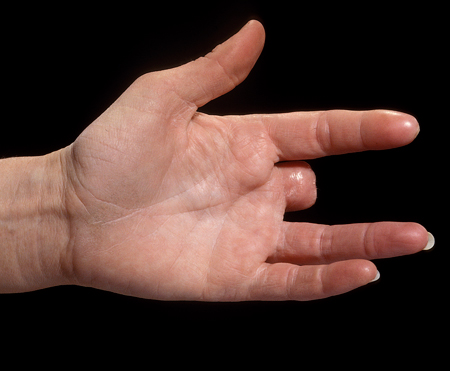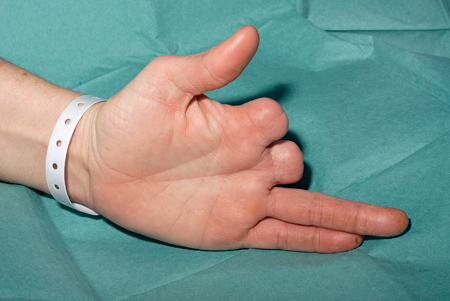Approach
Patients often present with critical ischemia and need admission to the hospital at the time of diagnosis. Critical ischemia is defined as gangrene or rest pain lasting >2 weeks and requiring regular opioid analgesia. Its definition may also include ankle pressure <50 mmHg. Patients with noncritical ischemia present with either claudication or new onset of rest pain.
Initial admission to the hospital involves confirming diagnosis, excluding differential diagnosis, and arterial imaging. Vasoactive dilation is done during initial admission to the hospital, along with any debridement of gangrenous tissue. Further treatments are given depending on severity of ischemia and degree of pain.
Smoking cessation
Smoking cessation reduces the incidence of amputation.[2][5] It improves patency and limb salvage rates in those who do undergo surgical revascularization.[31][32] From a group of 43 patients who stopped smoking, 94% avoided an amputation.[33] Patients who continue to smoke have a 19% major amputation rate; this is 2.73 times greater than for people who have ceased smoking, according to one study.[32][34][Figure caption and citation for the preceding image starts]: A cold ischemic middle finger in a woman who smokesFrom the collection of Matthew J. Metcalfe and Alun H. Davies [Citation ends]. [Figure caption and citation for the preceding image starts]: Subsequent middle finger amputation in a woman who continued to smokeFrom the collection of Matthew J. Metcalfe and Alun H. Davies [Citation ends].
[Figure caption and citation for the preceding image starts]: Subsequent middle finger amputation in a woman who continued to smokeFrom the collection of Matthew J. Metcalfe and Alun H. Davies [Citation ends]. [Figure caption and citation for the preceding image starts]: Subsequent index finger amputation in a woman who continued to smokeFrom the collection of Matthew J. Metcalfe and Alun H. Davies [Citation ends].
[Figure caption and citation for the preceding image starts]: Subsequent index finger amputation in a woman who continued to smokeFrom the collection of Matthew J. Metcalfe and Alun H. Davies [Citation ends].
Smoking increases flare-ups and reduces ulcer healing. A return to smoking following cessation may lead to a flare-up of the disease. Risk of Buerger disease is thought to be increased by "bidi" (a home-made cigarette consisting of low-quality tobacco and smoked without filters) smoking, which is likely related to cannabis arteritis associated with cannabis use.[9][10]
Smoking only 1 or 2 cigarettes a day, using smokeless tobacco (chewing tobacco), or using nicotine replacement therapy may all keep the disease active.[19][20]
Additional therapies
Several additional therapies have shown some benefit, but the most definitive treatment in the treatment of Buerger disease is smoking cessation.
Vasoactive drugs
Nifedipine, a calcium-channel blocker, may cause peripheral vasodilation and improve distal blood flow.[5] It has been shown to be of benefit in patients with lower limb trophic changes and symptoms, and is often given in combination with other therapies such as cessation of smoking, antibiotics, and iloprost.[35][36]
Pentoxifylline and cilostazol have had good effects, although there are few supportive data. They are not routinely used. Pentoxifylline has been shown to improve pain and healing in ischemic ulcers.[37] Treatment with pentoxifylline can be tried after other medical therapies have failed. Cilostazol could be tried in conjunction with or following failure of other medical therapies (e.g., nifedipine).[38] It is contraindicated in the following: patients with unstable angina, recent myocardial infarction, or coronary intervention (within 6 months); patients receiving 2 or more other antiplatelet agents or anticoagulants; and patients with history of severe tachyarrhythmia.
Iloprost is a prostacyclin glandin analog that may be given intravenously. It has been shown to be beneficial in relieving rest pain and in healing 62% of ulcers within 4 weeks following a 24-day course.[39][40] The effects of intravenous prostacyclin analog iloprost, intravenous prostacyclin analog clinprost, and intravenous prostaglandin analog alprostadil have been compared and showed no significant difference between them, suggesting they are all beneficial at healing ulcers and resolving rest pain at 28 days. However, the quality of evidence in these studies was low to very low.[41] Iloprost, when given orally, shows little significant benefit in regards to ulcer healing, pain, and amputation rates.[42] It is not available as an intravenous or oral formulation in the US.
Antibiotics
The choice of antibiotics depends on local hospital policies. Antibiotics are indicated only in the presence of infection or wet gangrene. Aerobic and anaerobic cover is needed. Amoxicillin/clavulanate may be adequate, or a penicillin plus metronidazole, or ciprofloxacin (if Pseudomonas present), or a third-generation cephalosporin plus metronidazole. If admission to the hospital is recommended (when patients present with critical ischemia), the antibiotics can be given intravenously.
Analgesia
For acute ischemic pain, acetaminophen and an opioid (weak or strong) are recommended, depending on the severity of pain.[43] Severe pain requiring analgesia often requires admission to the hospital so that disease can be controlled or the extent of disease can be assessed.
Nonsteroidal anti-inflammatory drugs (NSAIDs) can be used to treat superficial venous thrombophlebitis. Admission to the hospital is not a requirement for giving NSAIDs but may occur if several medical options are being tried while observing disease severity.
Spinal cord stimulation may also be beneficial. It has been shown to benefit patients with lower limb symptoms ranging from claudication and pain to ulceration and trophic changes. It is often used after medical therapy has failed. Spinal cord stimulation is performed by an implantable stimulator.[44][45][46]
Sympathectomy
This can be chemical or surgical, lumbar, or thorascopic. Both positive and negative results have been reported with lumbar sympathectomy.[47][40] Sympathectomy may be sufficient to enable necrotic lesions to heal.[48] It is thought to reduce pain by reducing peripheral resistance and promoting collateral development.[49] Thorascopic sympathectomy can be used for upper limb symptoms, and lumbar sympathectomy for lower limb symptoms. Due to the invasiveness of the procedure, sympathectomy is often a treatment tried when medical therapy has failed and there is no revascularization option. It is often used in the more severe cases where there is tissue loss. However, its use has been reported in patients presenting with claudication.[50]
Intra-arterial thrombolysis
Revascularization of crural vessels has been reported using intra-arterial thrombolysis, although it is not a commonly performed treatment modality in Buerger disease.[51]
Surgical revascularization
Due to the lack of patent distal vessels, bypass is often not an option. Angiography may reveal potential distal anastomotic sites allowing bypass to help ulcer healing. However, primary graft patency rates are 41% at 1 year, 32% at 5 years, and 30% at 10 years; secondary patency rates are 54% at 1 year, 47% at 5 years, and 39% at 20 years.[32]
Surgical revascularization is indicated mainly in patients with critical ischemia. Patients with noncritical ischemia are only indicated for surgical revascularization if there is severe claudication and a good distal vessel to anastomose onto distally.
Amputation
If part of a limb is clearly nonviable from the outset or attempts at revascularisation should fail, amputation is required. Careful consideration of the most appropriate type and level of amputation should be made in consultation with the patient, bearing in mind factors such as likelihood of successful healing, patient motivation and social circumstances, and the patient's potential functional outcomes with an appropriate prosthesis, if required.
In one study, 34% of patients had an amputation within 15 years of diagnosis.[2] The amputation-free survival rates at 5 and 10 years were 85% and 74%, respectively. Limb infection was associated with an increased amputation rate.[2]
Use of this content is subject to our disclaimer